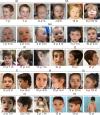Mutations in the small nuclear RNA gene RNU2-2 cause a severe neurodevelopmental disorder with prominent epilepsy
- PMID: 40210679
- PMCID: PMC12165851
- DOI: 10.1038/s41588-025-02159-5
Mutations in the small nuclear RNA gene RNU2-2 cause a severe neurodevelopmental disorder with prominent epilepsy
Abstract
The major spliceosome includes five small nuclear RNA (snRNAs), U1, U2, U4, U5 and U6, each of which is encoded by multiple genes. We recently showed that mutations in RNU4-2, the gene that encodes the U4-2 snRNA, cause one of the most prevalent monogenic neurodevelopmental disorders. Here, we report that recurrent germline mutations in RNU2-2 (previously known as pseudogene RNU2-2P), a 191-bp gene that encodes the U2-2 snRNA, are responsible for a related disorder. By genetic association, we identified recurrent de novo single-nucleotide mutations at nucleotide positions 4 and 35 of RNU2-2 in nine cases. We replicated this finding in 16 additional cases, bringing the total to 25. We estimate that RNU2-2 syndrome has a prevalence of ~20% that of RNU4-2 syndrome. The disorder is characterized by intellectual disability, autistic behavior, microcephaly, hypotonia, epilepsy and hyperventilation. All cases display a severe and complex seizure phenotype. We found that U2-2 and canonical U2-1 were similarly expressed in blood. Despite mutant U2-2 being expressed in patient blood samples, we found no evidence of missplicing. Our findings cement the role of major spliceosomal snRNAs in the etiologies of neurodevelopmental disorders.
© 2025. The Author(s).
Conflict of interest statement
Competing interests: The authors affiliated with deCODE genetics/Amgen Inc. (B.O.J., K. Stefansson and P.S.) are employed by the company. The other authors declare no competing interests.
Figures












Update of
-
Mutations in the U2 snRNA gene RNU2-2P cause a severe neurodevelopmental disorder with prominent epilepsy.medRxiv [Preprint]. 2024 Sep 4:2024.09.03.24312863. doi: 10.1101/2024.09.03.24312863. medRxiv. 2024. Update in: Nat Genet. 2025 Jun;57(6):1367-1373. doi: 10.1038/s41588-025-02159-5. PMID: 39281759 Free PMC article. Updated. Preprint.
References
MeSH terms
Substances
Grants and funding
- R01 HL161365/HL/NHLBI NIH HHS/United States
- R01HL161365/U.S. Department of Health & Human Services | NIH | National Heart, Lung, and Blood Institute (NHLBI)
- WT_/Wellcome Trust/United Kingdom
- R03 HD111492/HD/NICHD NIH HHS/United States
- R03HD111492/U.S. Department of Health & Human Services | NIH | Eunice Kennedy Shriver National Institute of Child Health and Human Development (NICHD)
LinkOut - more resources
Full Text Sources
Medical

